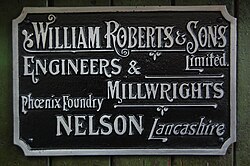William Roberts & Co of Nelson

Makers plate on the engine at Queen Street Mill
|
|
| Industry | Heavy engineering |
|---|---|
| Defunct | 1959 |
| Headquarters |
Phoenix Foundry, Nelson, Lancashire, England |
Phoenix Foundry, Nelson, Lancashire, England
William Roberts and Company (later William Roberts and Sons) of Phoenix Foundry in Nelson, Lancashire, England, produced many of the steam engines that powered cotton weaving and spinning mills of Pendle and neighbouring districts. Industrial historian Mike Rothwell has called Phoenix foundry “Nelson’s most significant engineering site”.
William was the son of a warper and was born in Burnley in 1833. He was educated first at Burnley Lane Head Elementary school and moved with his parents to Little Marsden (today part of Nelson) and completed his education at Little Marsden National School. At the age of thirteen he began an apprenticeship at Bridge Foundry, situated in Chapel Street at a site that later became part of Bridge Mills and is where Wavelengths Leisure Centre stands today. Bridge Foundry was started in 1845 by James and John Landless, engineers at Marsland's Burnley Ironworks. After completing his apprenticeship, William left Bridge Foundry and went to work at Burnley Ironworks, then run by Peter and William Marsland.
A Conservative and Freemason, Roberts married Kezia Burrows in 1858 and they had ten sons and two daughters.
He was a proponent of the 'Room and Power' system where a mill was built with an engine and various organisations installed their own looms, renting 'Room' for them and 'Power' to run them and was a founder member of the Nelson Room and Power Company.
Marsland's ironworks closed in 1861 and William Roberts then returned to Nelson with Peter and William Marsland. In August 1862 they bought a plot of land from J. and J. Walton in Hibson Street and formed a new iron founding business called Marsland, Roberts and Company. They were joined in this venture by Henry Greenwood, John Brennand and James Landless who became the engineer for the new firm. The iron foundry was named Phoenix Foundry and struggled to find work initially due to the impact of the American Civil War and resulting cotton famine. The company did, however, secure contracts for the supply of pumping engines for coal mines and for engines powering Walverden Shed, Nelson and the Entwistle Mill Manufacturing Company.
...
Wikipedia
